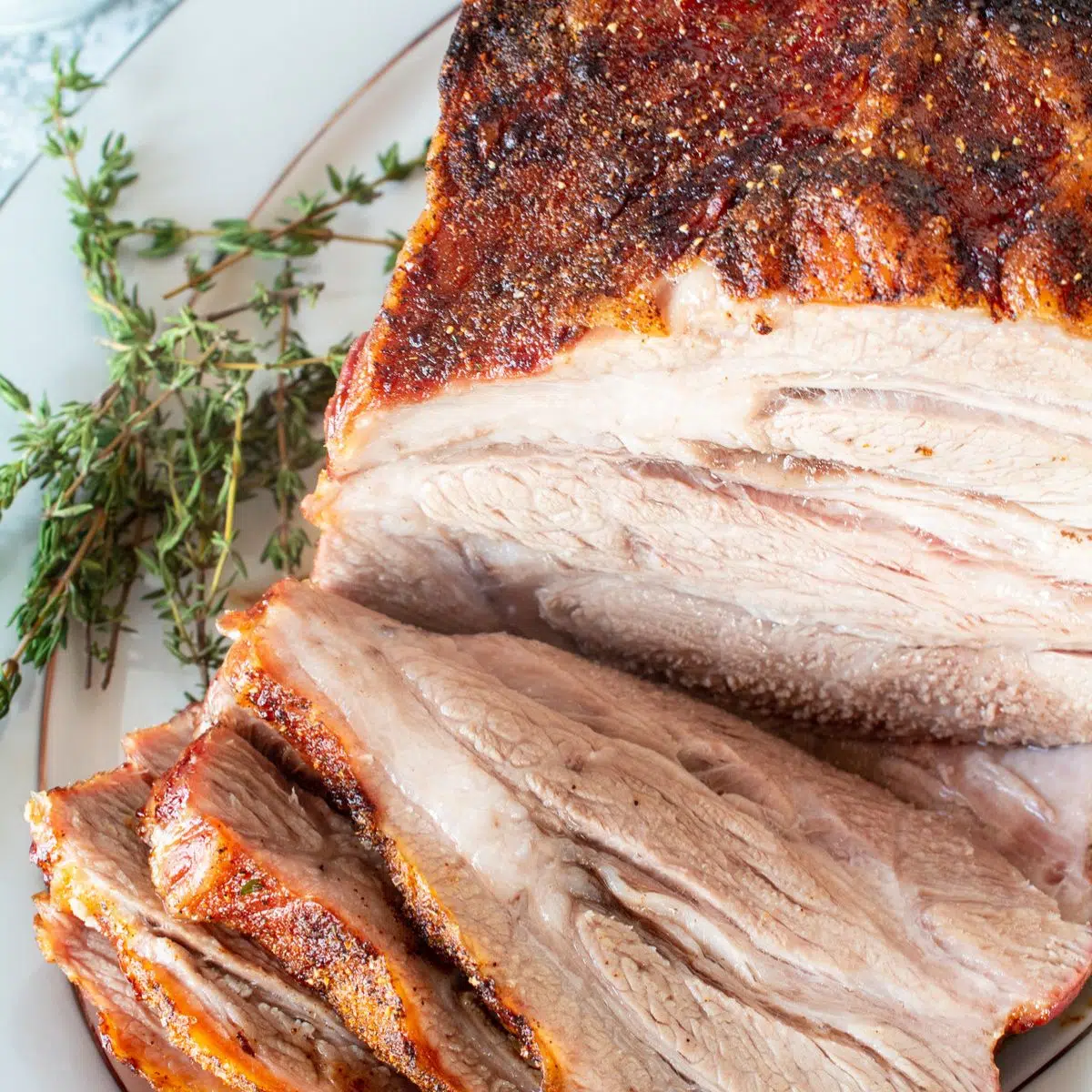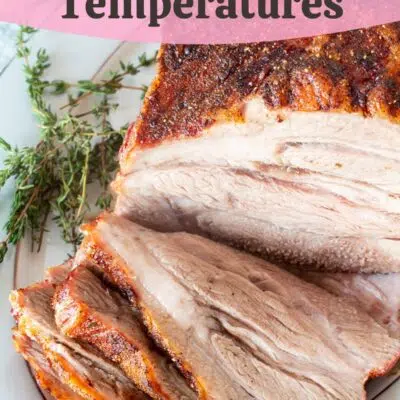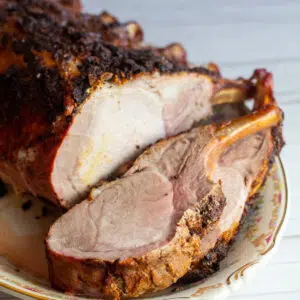Learning pork internal temperatures will help you make juicy, delicious pork recipes that are also safe to enjoy! From pork chops to ground pork, they all need to be cooked to a specific level of doneness. Luckily, everything you need to know about safely cooking pork can be found right here!
Ideal Pork Internal Temperature
The internal temperature of beef is commonly discussed. Even if people are not positive about the exact number, almost everyone knows whether they prefer a cut of beef to be rare, well-done, or somewhere in between.
However, beef is not the only type of meat that you should be aware of the internal temperature. Every type of meat that you cook has an ideal recommended temperature that it should be cooked to. This includes pork.

Jump to:
- Ideal Pork Internal Temperature
- Why the Internal Temperature is Important
- How to Check the Internal Temperature of Pork
- Ideal Internal Temperature for Pork
- Internal Temperature for Ground Pork
- Internal Temperature for Precooked Ham
- The Internal Temperature for Pork Ribs
- Tips for Letting Pork Rest After Cooking
- Pork Temperatures Reference Chart
- 🥩 Tasty Pork Recipes
- 📖 Recipe Card
- 💬 Comments & Reviews
Why the Internal Temperature is Important
The recommended internal temperature for every type of meat (and every cut of meat) is set by the USDA. Each temperature is recommended based on what has been determined the minimum temperature that each meat needs to reach to be safe to eat.
Even though people have personal preferences on how they like to eat different cuts of meat, it is always recommended that the minimum internal temperature be met. Meeting the internal temperature ensures that potential parasites or bacteria have been killed by the heat. Therefore, helping you avoid the risk of food poisoning or other food-borne illnesses.
How to Check the Internal Temperature of Pork
As with any type of meat, a meat thermometer is the best way to check for doneness. You can use a digital or an analog thermometer.
If you don’t own a meat thermometer, analog ones are a little less expensive. However, a digital one is easier to read. If you do a lot of cooking with any type of meat a digital meat thermometer is a great investment for your kitchen.
How to Use the Meat Thermometer
To use the thermometer, insert it into the thickest part of the pork. With pork chops and pork loins, you can usually insert it vertically. This will work for meatballs as well.
However, with thinner cuts of meat, you will get a better read by inserting the thermometer horizontally through the side of the pork chop. Whether you use a digital thermometer or an analog one, using a thermometer will guarantee that your pork is done.
How to Measure the Internal Temperature Without a Thermometer
Unfortunately, there is no way to measure the exact internal temperature of pork without a thermometer. To be sure your pork is fully cooked, I recommend using a thermometer.
However, with certain smaller cuts of meat like (pork ribs or cutlets), it can be difficult to use a thermometer. These smaller cuts of pork often don’t have enough meat to insert the thermometer far enough. Moreover, with ribs, the large bones can also get in the way.
If measuring a pork cutlet that does not have a bone in it, first try to insert the thermometer horizontally to get a reading. If that doesn’t work, cut into the middle. Look for the edges to be opaque white. The center can be slightly pink, but should still be almost opaque.
For smaller cuts that have a bone, follow the suggestions below for the internal temperature of pork ribs.
Ideal Internal Temperature for Pork
The USDA recommends that fresh cuts of pork reach an internal temperature of at least 145°F (63°C)Fresh cuts of pork include cuts that have been minimally processed, like pork chops and pork loins.
At this temperature, these cuts of pork are considered medium-rare. Since pork chops and pork loins are quite lean cuts of meat, this temperature of the desired doneness allows for the meat to be juicy and not overcooked (while still being safe to eat).
However, even though pork is safe at this level of doneness some people prefer pork to be cooked more fully. Here is a chart to help you determine your desired level of doneness based on the internal temperature.
- Medium-Rare: 145-150°F (63-66°C)
- Medium: 150-155°F (66-68°C)
- Medium-Well: 155-160°F (68-71°C)
- Well: 160°F (71°C)
Internal Temperature for Ground Pork
Ground pork is a popular ingredient in many dishes. It can be used alone to make meatballs or mixed with other cuts of meat to elevate the flavors in a dish (like a beef and pork meatloaf). However, when pork is ground it creates more opportunities for bacteria to form.
Therefore, the meat needs to be cooked longer and to a higher temperature. Whether you are using ground pork on its own or mixed with another meat make sure to cook the pork until it reaches an internal temperature of 160°F (71°C).
Internal Temperature for Precooked Ham
Sometimes we forget, but ham is a type of pork. However, unlike other cuts of pork that are usually bought raw, ham is typically pre-cooked before it is sold.
Since ham has already been cooked before being sold it does not have to be cooked as long as other cuts of pork. Moreover, it does not have to reach the same minimum internal temperature.
It is recommended that a pre-cooked ham is heated until it reaches an internal temperature of 140°F (60°C). At this temperature, you will have a nice hot ham that is still juicy. If you cook it beyond this temp, you run the risk of drying out the meat.
The Internal Temperature for Pork Ribs
If you can get an accurate reading, then the best temperature for pork ribs is about 200°F (93°C). The dark meat found in pork ribs is tougher than the leaner white meat found in other cuts of pork. Therefore, the longer the meat can cook the better.
Cooking the meat longer until it reaches a higher internal temperature allows the connective tissue of the dark meat to break down. This results in the tender fall off the bone meat which is often the goal when cooking ribs.
Using a thermometer can be difficult on pork ribs. There is often not a thick enough section, and the bones get in the way. If you can use a thermometer, that is best. However, if you can’t get an accurate read the best way to know they are done is when the meat starts to pull away from the bones.
Tips for Letting Pork Rest After Cooking
As with most types of meat, it is suggested to let the pork rest for a bit before serving. However, unlike beef which you typically let rest for anywhere from 10 minutes to 30 minutes, pork does not need the same amount of time.
Pork should rest for at least 3 minutes once it comes away from the heat. This allows for the juices to thicken and settle. Moreover, it allows for the meat to finish cooking.
Typically, pork does not rest for much longer than a few minutes though. Therefore, while it is suggested that you remove beef from the oven before it has reached the desired internal temperature that is not suggested with pork.
Wait to remove the pork until it has reached the desired internal temperature provided above. Then let it sit for 3-5 minutes before serving. This will ensure a fully cooked piece of pork that is still juicy and delicious.

Pork Temperatures Reference Chart
| Cut Of Pork | Size | Internal Temp | Cooking Time |
| Spareribs (St. Louis style) | 3 ½ to 4 pounds per rack | 200°F (93°C) | 1 ¼ to 1 ½ hours until tender |
| Pork Back Ribs | 1 ½ to 2 pounds per rack | 200°F (93°C) | 1 ¼ to 1 ½ hours until tender |
| Country-Style Ribs | 3 to 4 pounds | 195°F (91°C) | 30 to 35 minutes until tender |
| Loin Chops (Bone-In) | ¾-inch | 145°F to 160°F (63-71°C) | 8 to 12 minutes |
| Ribeye (Rib) Pork Chop | ¾-inch | 145°F to 160°F (63-71°C) | 8 to 12 minutes |
| Porterhouse (Loin) Pork Chops | ¾-inch | 145°F to 160°F (63-71°C) | 8 to 12 minutes |
| Sirloin Pork Chop | ¾-inch | 145°F to 160°F (63-71°C) | 8 to 12 minutes |
| Loin Chops (Boneless) | ¾-inch | 145°F to 160°F (63-71°C) | 6 to 10 minutes |
| Ribeye (Rib) Pork Chop | ¾-inch | 145°F to 160°F (63-71°C) | 6 to 10 minutes |
| New York (Top Loin) Pork Chop | ¾-inch | 145°F to 160°F (63-71°C) | 6 to 10 minutes |
| Sirloin Pork Chop | ¾-inch | 145°F to 160°F (63-71°C) | 6 to 10 minutes |
| Blade (Boston) Pork Roast | 3 to 6 pounds | 145°F to 160°F (63-71°C) | 2 to 2 ½ hours until tender |
| Arm (Picnic) Pork Roast | 3 to 4 pounds | 145°F to 160°F (63-71°C) | 30 to 33 minutes each pound until tender |
| Arm (Picnic) Pork Roast | 5 to 6 pounds | 145°F to 160°F (63-71°C) | 26 to 29 minutes each pound until tender |
| Pork Belly | 2 ½ to 3 pounds | 160°F (71°C) | 40 minutes each pound until tender |
| Tenderloin Medallions | ½-inch | 145°F to 160°F (63-71°C) | 8 to 10 minutes until tender |
| Cutlets | ½-inch | 145°F to 160°F (63-71°C) | 3 to 4 minutes until tender |
| Loin Cubes | 1-inch | 145 °F (63°C) | 8 to 10 minutes until tender |
🥩 Tasty Pork Recipes
- Instant Pot Pulled Pork - This pulled pork couldn't be easier and it makes delicious sandwiches!
- Pork Shoulder Butt Roast - This roast is melt-in-your-mouth tender and surprisingly easy to make!
- Pork Belly Burnt Ends - These pork belly burnt ends taste like little morsels of meat candy!
- Grilled Pork Steaks - Grilled pork steaks are juicy and flavorful, all the reason you need to fire up the grill!
- Air Fryer Stuffed Pork Chops - Easy pork chops stuffed with fluffy Stovetop Stuffing, yes please!
- Baked Pork Tenderloin - This baked pork tenderloin has a perfect golden-brown sear and a flavorful pork dry rub!
With the ideal pork internal temperatures you can make sure you are making safe and delicious pork recipes for your family and friends! Let us know which pork recipe you plan on making first by leaving us a comment below!
Do you love a recipe you tried? Please leave a 5-star 🌟rating in the recipe card below and/or a review in the comments section further down the page.
Stay in touch with me through social media @ Pinterest, Facebook, Instagram, or Twitter! Subscribe to the newsletter today (no spam, I promise)! Don't forget to tag me when you try one of my recipes!
📖 Recipe Card
Pork Internal Temperatures: Roasted Rack of Pork (+ Ideal Temps For More Pork Recipes)
Ingredients
- 4½ lbs rack of pork (7-8 bone rib roast, center cut)
- ¼ cup Dijon mustard (or German mustard, or olive oil)
- 4 medium carrots (chopped)
- 3 ribs celery (chopped)
- 1 medium yellow onion (chopped)
- 1 large apple (Braeburn, or another semi-sweet firm variety)
- 6 cloves garlic
- 1 cup chicken broth (or water)
- 2½ tablespoon pork seasoning (½ recipe, or use your favorite brand)
(Note: 2x or 3x only changes the ingredient list)
Instructions
- To get started, preheat your oven to 450°F (230°C).
- Roughly chop your carrots, celery, onion, and apple and place them into a roasting pan alongside the whole, peeled garlic cloves. Then pour in the chicken broth (or water) and place your roasting rack on top.
- To prepare your pork, rinse it with cool water and pat it dry. Next, coat all of the sides with Dijon mustard and then generously season it with pork seasoning before placing it onto the roasting rack fat side up.
- Once your oven is preheated, place the rack of pork into the oven and cook it for 15 minutes. Then reduce the temperature to 325°F (165°C) and continue to roast the pork for 1½-2 hours, or until the internal temperature reaches 145°F (65°C) (*see note).
- After your rack is done cooking, remove it from the oven and transfer it to a large platter or cutting board. Cover the cooked roast loosely with a sheet of aluminum foil, and allow it to rest for 15-20 minutes before slicing and serving (*see note).
Notes
- The actual weight of your rack can vary, thus leading to different cook times. The average weight for a 7-8 bone pork rack is 4 ½ pounds/2 kilograms.
- The best way to know when your pork is done cooking is by using a meat thermometer and checking the internal temperature in multiple places. You want the temperature to read 145°F (65°C) for medium.
- It is incredibly important to let your meat rest for the full 15-20 minutes. If you don't the juices will all run out, leaving you with dry meat.
- Don't trim any excess fat away before cooking as it adds flavor! You always want to roast your pork with the fat side up so that all of the juices and flavor runs through the meat while it cooks, instead of straight into the pan.
- To store: Slice your rack to make storage easier, and place the meat into an airtight container in the fridge for up to 3 days. Alternatively, leftovers can be tightly wrapped in heavy duty aluminum foil.
- To freeze: Place your fully cooked rack into a freezer-safe, sealed container for up to 3 months. Allow it to thaw completely in the fridge before reheating.
- To reheat: Bake your leftovers in a preheated oven at 350° (180°C) for 30 minutes, and then allow it to rest for 15 minutes before serving.



Comments
No Comments